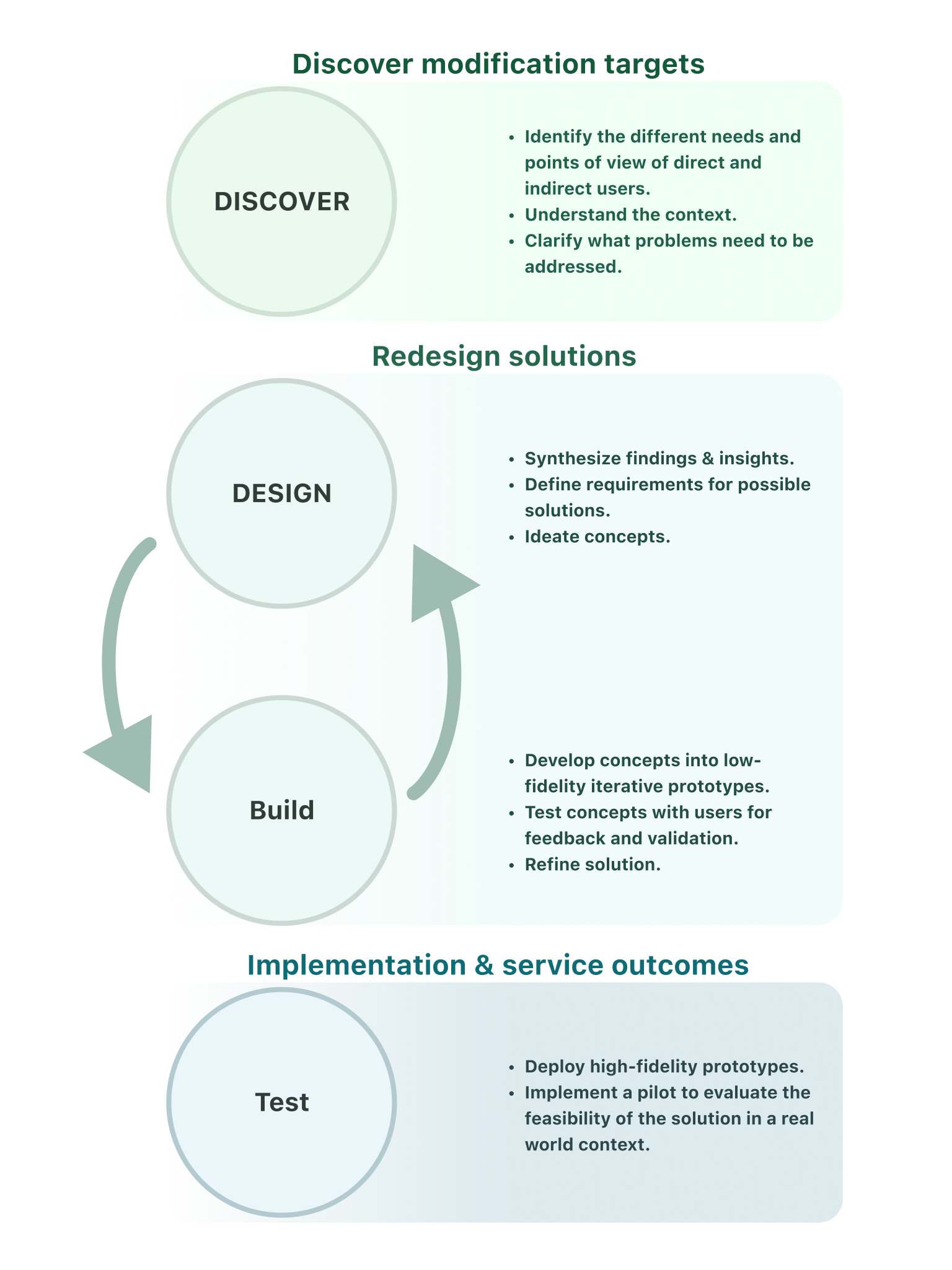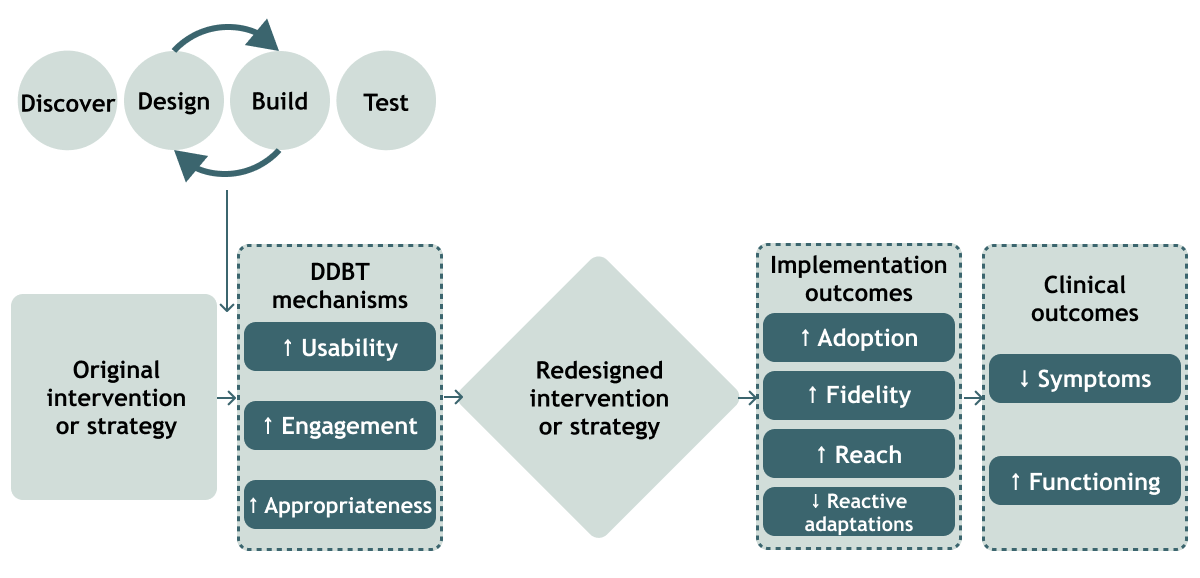What is the Discover, Design/Build, Test (DDBT) Framework?

The UW ALACRITY Center (UWAC) developed the Discover, Design and Build, and Test (DDBT) framework to guide teams in redesigning clinical interventions (e.g., psychotherapies) and implementation strategies (e.g. training) (CIs/ISs) to improve usability, engagement, appropriateness, while preserving core components of interventions.
- Usability is the extent to which CIs/ISs can be used to achieve specified goals with effectiveness, efficiency, and satisfaction
- Engagement is degree of user participation and enthusiasm for the aspects of CIs/ISs that require user involvement
- Appropriateness is perceived fit, relevance, or compatibility of CIs/ISs for a given practice setting, practitioner, or consumer
We believe that greater attention to usability, engagement, and appropriateness in the design or design of an intervention can improve key implementation outcomes. These outcomes include adoption, fidelity, reach, and the number and scale of changes organizations or individuals later make to align the intervention or implementations strategy with their constraints and preferences (reactive adaptations). This, in turn, should improve clinical outcomes at both the population and individual level.

Key principles of DDBT
DDBT is informed by human-centered design (HCD) and implementation science, both of which strive to enhance adoption of tools and innovations. Key principles:
- Not all CIs/ISs are designed for all settings
- There is no implementation without adaptation
- Unchecked, reactive adaptations have the potential to exclude essential active ingredients
- Reactively adapted CIs/ISs can negatively impact implementation and clinical outcomes
DDBT Theory of Change and Comparison to Other Frameworks
The DDBT framework is an iterative approach to systematically (1) understand the system/environment, practitioner, client burdens, and constraints of existing CIs/ISs; (2) iteratively design solutions with users, and (3) test and refine prototypes.
DDBT captures elements of the many frameworks and models from IS and HCD that cover the translation of research into practice. The table below summarizes goals of each DDBT phase and comparisons to other frameworks.
| DDBT Phase | Goal | Comparison examples |
|---|---|---|
| Discover | Identifying multilevel factors that drive CI/IS usability problems, engagement challenges, and problems with contextual appropriateness | Implementation Science – Process models – Determinant frameworks (ie, Consolidated Framework for Implementation Research (CFIR) and Practical, Robust Implementation and Sustainability Model (PRISM)) – Classic theories (i.e., Diffusion of Innovation) – Implementation theories (i.e., Organizational Readiness for Change) HCD – d.school Design Thinking steps “empathize” and “define” – IDEO Three-Stage Design Thinking step “inspiration” – Design Council Double Diamond steps “research” and “insight” within the Discover and Define phases |
| Design/Build | Using problems and challenges identified during the Discover phase, modifications are iteratively created between the design team and local practitioners/clients, until a new version of the CI/IS is developed to address crucial issues and enhance usability, engagement, and appropriateness | Implementation Science – Evaluation frameworks (i.e., FRAME, RE-Aim) HCD – d.school Design Thinking steps “ideate”, “prototype”, and “test” – IDEO Three-Stage Design Thinking step “ideation” – Design Council Double Diamond step “ideation” within the Develop phases |
| Test | Testing the Design/Build phase solution against the original version to determine if the redesigned solution results in improved implementation and clinical outcomes | Implementation Science – Evaluation frameworks (ie FRAME, RE-Aim) HCD – d.school Design Thinking step “test” – IDEO Three-Stage Design Thinking step “implementation” – Design Council Double Diamond step “prototype” within the Deliver phases |
How might you use DDBT?
DDBT is intended to be flexible and non-linear, where a project evolves as insights from users are incorporated throughout the process. Our hope is that DDBT will be used by both researchers and community organizations to support redesign of evidence-based practices. Below we outline some suggestions on how you might get started using DDBT. While we offer examples of methods and approaches you could consider, you should not limit yourself to what we’ve outlined. Any approach should be based on your design objectives and potentially adapted based on project and contextual needs.
Discover
Objective: Identify multilevel factors that drive CI/IS usability problems, engagement challenges, and problems with contextual appropriateness
Example activities:
- Literature review of existing barriers and facilitators to CIs/ISs
- Interviews, focus groups, or surveys with users to understand their background, motivations, or attitudes towards existing CIs/ISs
- Observation of CIs/ISs being delivered in care settings
- Diary study where users share their daily activities or experiences with CIs/IS
- Cognitive walkthrough or heuristic evaluation of CIs/ISs
- Usability testing of existing CIs/ISs
PST case study:
- Interviews and observations of new and experienced PST trainers
- Diary study of clients receiving PST
Design/Build
Objective: Modify and iteratively create a new version of the CI/IS to address crucial issues and enhance usability, engagement, and appropriateness
Example activities:
- Co-design sessions to prototype redesigned CIs/ISs
- Cognitive walkthrough or heuristic evaluation of CIs/ISs
- Usability testing of lower-fidelity designs with users
PST case study:
- Co-design sessions and prototyping of potential products to enhance fidelity when conducting PST resulting in PST-Aid
Test
Objective: Test the redesigned solution against the original version to determine if the redesigned solution results in improved implementation and clinical outcomes
Example methods:
- Usability testing of higher-fidelity prototypes
PST case study:
- Pilot randomized trial comparing PST training-as-usual to training plus PST-Aid
